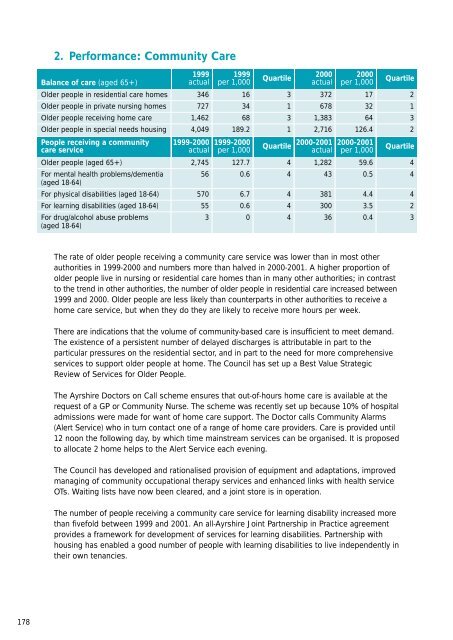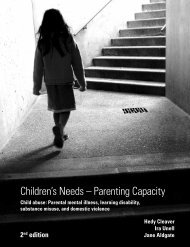- Page 1 and 2:
Growth and DevelopmentSOCIAL WORK S
- Page 4 and 5:
IntroductionThe Local ReportsGrowth
- Page 6 and 7:
ContentsPageNorth Lanarkshire 183Or
- Page 8 and 9:
1. Profile at 2002With an estimated
- Page 10 and 11:
AberdeenThe three councils and heal
- Page 12 and 13:
AberdeenBehavioural support teacher
- Page 14 and 15:
AberdeenStaff6. StaffingManagers &
- Page 16:
AberdeenThe Council is still some w
- Page 19 and 20:
2. Performance: Community CareBalan
- Page 21 and 22:
In an Equal Chances project the Cou
- Page 23 and 24:
Staff6. StaffingManagers & central
- Page 26 and 27:
1. Profile at 2002Angus is a medium
- Page 28 and 29:
AngusAcross Angus, there are multi-
- Page 30 and 31:
AngusAlthough the crime rate is bel
- Page 32:
Angus8. The FutureA sound foundatio
- Page 35 and 36:
2. Performance: Community CareBalan
- Page 37 and 38:
3. Performance: Children and famili
- Page 39 and 40:
Current management information syst
- Page 41 and 42:
8. The FutureThe reorganisation of
- Page 43 and 44:
2. Performance: Community CareBalan
- Page 45 and 46:
The Council is preparing to adminis
- Page 47 and 48:
7. Modernising servicesA local work
- Page 49 and 50:
2. Performance: Community CareBalan
- Page 51 and 52:
The social services department is i
- Page 53 and 54:
5. FinanceService Area(£000)Childr
- Page 56 and 57:
1. Profile at 2002Dundee is a mediu
- Page 58 and 59:
DundeeDundee is participating in a
- Page 60 and 61:
Dundee4. Performance: Criminal Just
- Page 62 and 63:
Dundeefor example, call centres.A n
- Page 64 and 65:
1. Profile at 2002East Ayrshire has
- Page 66 and 67:
East AyrshireThe pan-Ayrshire menta
- Page 68 and 69:
East Ayrshire4. Performance: Crimin
- Page 70:
East Ayrshire8. The FutureIf the Co
- Page 73 and 74:
2. Performance: Community CareBalan
- Page 75 and 76:
Rates of child protection referrals
- Page 77 and 78:
5. FinanceService Area(£000)Childr
- Page 79 and 80:
Services for people with a sensory
- Page 81 and 82:
2. Performance: Community CareBalan
- Page 83 and 84:
A high rate of children are placed
- Page 85 and 86:
Staff6. StaffingVacanciesWTE1999act
- Page 88 and 89:
1. Profile at 2002East Renfrewshire
- Page 90 and 91:
East RenfrewshireA shared assessmen
- Page 92 and 93:
East Renfrewshire5. FinanceService
- Page 94:
East RenfrewshireServices for peopl
- Page 97 and 98:
2. Performance: Community CareBalan
- Page 99 and 100:
The rate of children on child prote
- Page 101 and 102:
5. FinanceService Area(£000)Childr
- Page 103 and 104:
8. The FutureThrough its onecity re
- Page 105 and 106:
2. Performance: Community CareBalan
- Page 107 and 108:
The Comhairle and NHS Western Isles
- Page 109 and 110:
A partnership approach is taken to
- Page 111 and 112:
Specific action which calls for con
- Page 113 and 114:
2. Coileanadh: Cùram Coimhearsnach
- Page 115 and 116:
Tha a’ Chomhairle agus NHS nan Ei
- Page 117 and 118:
Tha dòigh-obrach com-pàirteachais
- Page 119 and 120:
Tha na leanas am measg nan gnìomha
- Page 121 and 122:
2. Performance: Community CareBalan
- Page 123 and 124:
3. Performance: Children and Famili
- Page 125 and 126:
5. FinanceService Area(£000)Childr
- Page 127 and 128: 8. The FutureAfter the best value r
- Page 129 and 130: 2. Performance: Community CareBalan
- Page 131 and 132: 3. Performance: Children and Famili
- Page 133 and 134: 5. FinanceService Area(£000)Childr
- Page 135 and 136: 134
- Page 137 and 138: 2. Performance: Community CareBalan
- Page 139 and 140: The rate of child protection referr
- Page 141 and 142: 5. FinanceService Area(£000)Childr
- Page 143 and 144: 7. Modernising servicesThere is a h
- Page 145 and 146: 2. Performance: Community CareBalan
- Page 147 and 148: 3. Performance: Children and Famili
- Page 149 and 150: A relatively low rate of social enq
- Page 151 and 152: To attract staff into social care t
- Page 153 and 154: 152
- Page 155 and 156: 2. Performance: Community CareBalan
- Page 157 and 158: Joint action is in progress to impl
- Page 159 and 160: Staff6. StaffingVacanciesWTE1999act
- Page 161 and 162: 160
- Page 163 and 164: 2. Performance: Community CareBalan
- Page 165 and 166: The rate of child protection referr
- Page 167 and 168: 5. FinanceService Area(£000)Childr
- Page 169 and 170: 8. The FutureThe Council and its he
- Page 171 and 172: 2. Performance: Community CareBalan
- Page 173 and 174: 3. Performance: Children and Famili
- Page 175 and 176: 5. FinanceService Area(£000)Childr
- Page 177: 176
- Page 181 and 182: 3. Performance: Children and Famili
- Page 183 and 184: A substantial increase in community
- Page 185 and 186: Social work staff have access to a
- Page 187 and 188: 2. Performance: Community CareBalan
- Page 189 and 190: There are low rates of child protec
- Page 191 and 192: Staff6. StaffingManagers & central
- Page 193 and 194: 192
- Page 195 and 196: 2. Performance: Community CareBalan
- Page 197 and 198: 3. Performance: Children and Famili
- Page 199 and 200: 5. FinanceService Area(£000)Childr
- Page 201 and 202: To maintain progress in improving t
- Page 203 and 204: 2. Performance: Community CareBalan
- Page 205 and 206: The rate of looked after children i
- Page 207 and 208: 5. FinanceService Area(£000)Childr
- Page 209 and 210: To complement improvements in commu
- Page 211 and 212: 2. Performance: Community CareBalan
- Page 213 and 214: Between 1998 and 2000 there was a l
- Page 215 and 216: 5. FinanceService Area(£000)Childr
- Page 217 and 218: 8. The FutureThe partnership agreem
- Page 219 and 220: 2. Performance: Community CareBalan
- Page 221 and 222: The number of child protection refe
- Page 223 and 224: 5. FinanceService Area(£000)Childr
- Page 225 and 226: 8. The FutureNumbers of older peopl
- Page 227 and 228: 2. Performance: Community CareBalan
- Page 229 and 230:
3. Performance: Children and Famili
- Page 231 and 232:
Local staff are devising a template
- Page 233 and 234:
8. The FutureThe provision of servi
- Page 235 and 236:
2. Performance: Community CareBalan
- Page 237 and 238:
3. Performance: Children and Famili
- Page 239 and 240:
5. FinanceService Area(£000)Childr
- Page 241 and 242:
240
- Page 243 and 244:
2. Performance: Community CareBalan
- Page 245 and 246:
A best value review of the sensory
- Page 247 and 248:
4. Performance: Criminal JusticeKey
- Page 249 and 250:
Measures to boost recruitment of so
- Page 251 and 252:
250
- Page 253 and 254:
2. Performance: Community CareBalan
- Page 255 and 256:
The rate of looked after children,
- Page 257 and 258:
5. FinanceService Area(£000)Childr
- Page 259 and 260:
8. The FutureTo maintain progress t
- Page 261 and 262:
2. Performance: Community CareBalan
- Page 263 and 264:
3. Performance: Children and Famili
- Page 265 and 266:
With West Dunbartonshire and Argyll
- Page 267 and 268:
7. Modernising servicesThe Council
- Page 269 and 270:
2. Performance: Community CareBalan
- Page 271 and 272:
• the educational environment for
- Page 273 and 274:
The total number of staff increased
- Page 275 and 276:
Children and FamiliesFigures are fr
- Page 277 and 278:
Appendix 2Statistical InformationFi
- Page 279 and 280:
Community Care ServicesTable 3 belo
- Page 281 and 282:
Table 5 Primary occupations in soci
- Page 283 and 284:
Highland2000 2016Inverclyde2000 201
- Page 285 and 286:
ISCJISISO 9002ITJoint Future Agenda
- Page 287:
Further copies are available from t
















